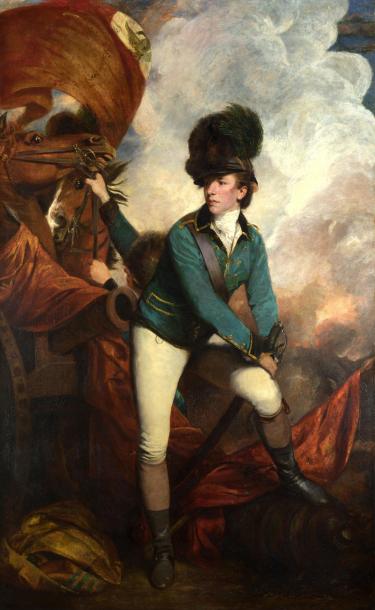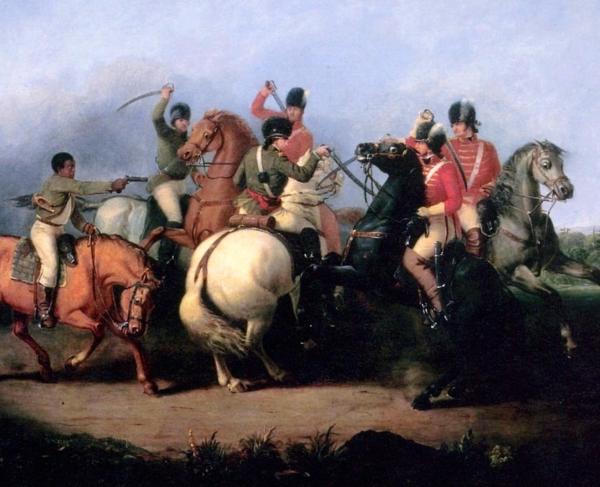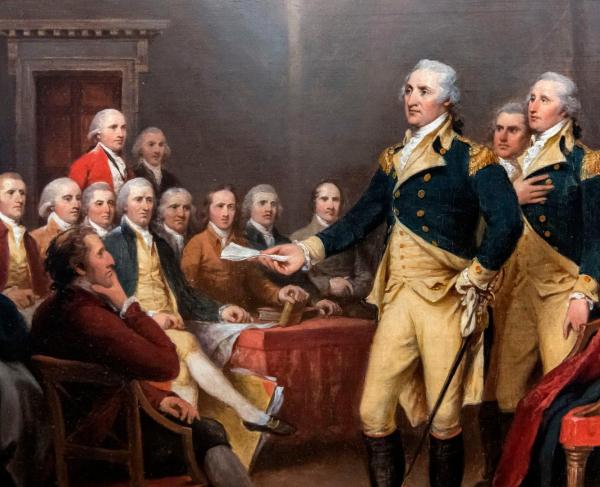Dueling in the Cowpens

If the American Revolution ever provided a British villain, that moniker would most likely fall on the person of Col. Banastre Tarleton. The twenty-six year-old Tarleton was an intrepid and fiery leader brimming with an arrogance that could be credited to his daringly successful battlefield exploits. Mixed with this arrogance was a mean streak, which American forces felt at their defeat at Waxhaws, South Carolina in May, 1780.
At Waxhaws, a small country campsite, the overrun patriot forces surrendered, only to find that Tarleton would rather his defeated foes be executed. Bragging after the event Tarleton boasted about his troops, that they displayed "a vindictive asperity not easily restrained." Thus the notion of “Tarleton’s Quarter” echoed throughout the southern American armies, only adding to Tarleton’s mystique and infamy while at the same time rallying flagging patriot support in the Southern Department. Tarleton was a dandy too, wearing a green uniform based on that of a Loyalist regiment organized in New York and a helmet with plume.

Tarleton’s notoriety was further fueled after an event that took place near the end of the Battle of Cowpens on January 19, 1781, a duel of sorts with the American cavalry commander Col. William Washington, a second cousin to the American Commander-in-Chief, George Washington. It is the stuff of high drama. Tarleton’s forces had been bested at Cowpens by Daniel Morgan’s combined force of Continental troops of the line and patriot militia. It was one of the most complete American victories of the American Revolution; called by some an American version of the Battle of Cannae, complete with a double envelopment. Morgan later described having given “Benny,” his derisive name for Tarleton, “a Devil of a whipping.”
Morgan had brilliantly deployed his men in three lines, putting the inexperienced and raw militia in the front, ordering them to fire two volleys into the British, and then to disperse to the rear of the American lines. It was a trap for the British, who charged uphill and saw the militia peel off, looking like another rout of the Americans. Unbeknownst to the surging British were the two other American lines which they suddenly encountered and which poured a steadfast and murderous fire into Tarleton’s men. Before they could recover, Washington’s cavalry plunged into both flanks of the British. Many of the British either fled or surrendered.
A stunned Tarleton tried to rally his men, but his efforts proved futile. Thus he led a vicious rear guard action as the bulk of his army withdrew. American dragoons moved in quickly for the kill. Close quarters combat ensued with the metallic sound of sabers against sabers rending the air.
It was a hot contest, men and animal bumping into one another, insults being hurled back and forth, and blood flowing. One combatant’s account claimed, “The affair in this quarter now became very animated.” As Tarleton’s cavalry gave ground Washington’s dragoons pursued the weary enemy. Washington typically rode well out in front of his men, and this January morning it was no exception. An incensed Tarleton wheeled around and sprinted headlong for Washington. Following behind him were several of his officers.
Again saber clanked against saber, and Washington’s sword was cut off at the hilt as he rose to stand in his saddle and parry a thrust from a British officer. As a British cavalryman moved in to finish Washington off, one of Washington’s African American combatants, who history has branded with several names, but who was most likely named Collins, shot the British officer in the shoulder before he could inflict damage on Washington. There was another thrust at Washington but another American cavalryman parried the blow with his saber. Tarleton joined the fray of the melee and took a swing at Washington, too, which Washington blocked with the hilt of his saber. As Tarleton reined up his horse he was surrounded by American cavalrymen, but made good his escape. As he fled the field of action he took a final shot at Washington which wounded Washington’s horse.
The battle lasted only an hour, but much had happened by 8:00 am that morning. All in all Morgan, Washington, and their men had embarrassed the British. It was another stinging defeat for the British in the Southern Campaign and one in a series of encounters that helped put in motion the subsequent defeat of General Cornwallis at Yorktown ten months later. The Southern British Campaign hinged on support from the large Loyalist population living in the Southern colonies. As General Cornwallis moved through the South the setbacks at Cowpens and Kings Mountain eroded his support from the Loyalists. Complicating matters, too, for Cornwallis was that his line of support was increasingly getting thin as he moved from his base in Charleston in a northerly direction. In March he would secure a tactical win over Nathanael Greene at Guilford Court House, North Carolina, but the price was so high that Cornwallis chose to move his army further north and east to resupply and refit on the Chesapeake Bay at Yorktown, Virginia. With the Southern Colonies not actually under control of the British, George Washington, whose main body of the Continental Army was located outside of New York City, opted to take advantage of the situation in the South, leaving behind a shadow army intended to convince the British he still remained on their front, while stealthily maneuvering south with the recent arrival of French troops as allies. The gamble worked and Cornwallis by October 1781 was enduring a siege, as the French navy succeeded in blocking any ability for the British Navy to reinforce Cornwallis.
Related Battles
149
868


